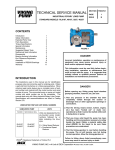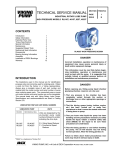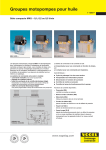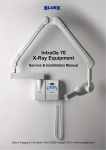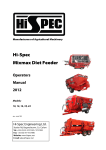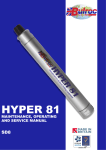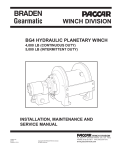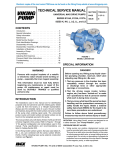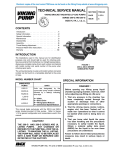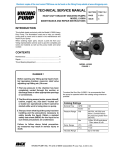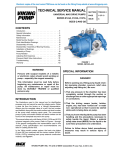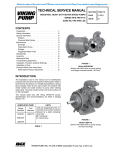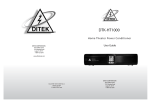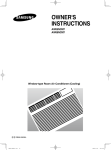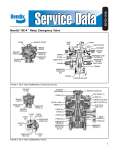Download TECHNICAL SERVICE MANUAL
Transcript
Electronic copies of the most current TSM issue can be found on the Viking Pump website at www.vikingpump.com TECHNICAL SERVICE MANUAL SECTION TSM 270 INDUSTRIAL ROTARY LOBE PUMP PAGE 1 of 10 Model RL41507 ISSUE F CONTENTS Safety Information Introduction Special Information Maintenance Suggested Repair Tools Disassembly Cartridge Seal Labyrinth Seal Assembly Thrust Bearing Adjustment Installation of PEEK® Bushings Warranty 1 1 4 4 5 5 6 7 7 8 9 12 TABLE OF ILLUSTRATIONS RL41507 Pump Assembly Exploded Pump Parts View Pump Rotation Head Removal Timing Gear Removal Use Of Bearing Puller Bracket Removal Fluidtec P/S®-II Cartridge Seal Lobe Positioning Bearing Housing Assembly Timing Gear Positioning 1 2 4 5 5 6 6 6 7 7 7 INTRODUCTION The illustrations used in this manual are for identification purposes only and cannot be used for ordering parts. Obtain a parts list from the factory or a Viking representative. Always give a complete name of part, part number and material with the model number and serial number of pump when ordering repair parts. The unmounted pump or pump unit model number and serial number are on the nameplate. This manual deals only with Viking Rotary Lobe Pumps. Specifications and recommendations are listed in Catalog Section 270. PEEK® is a trademark of Victrex PLC. FIGURE 1 MODEL RL41507 DANGER! Incorrect installation, operation or maintenance of equipment may cause severe personal injury or death and/or equipment damage. This information must be read fully before beginning installation, operation or maintenance and must be kept with the pump. It is suggested that suitably trained or qualified persons perform all installation and maintenance procedures. DANGER ! Before opening any Viking pump liquid chamber (pumping chamber, reservoir, etc.) be sure: 1. That any pressure in the chamber has been completely vented through the suction or discharge lines or other appropriate openings or connections. 2.That the driving means (motor, turbine, engine, etc.) has been “locked out” or made non-operational so that it cannot be started while work is being done on pump. 3.That you know what liquid the pump has been handling and the precautions necessary to safely handle the liquid. Obtain a material safety data sheet (MSDS) for the liquid to be sure these precautions are understood. 4.That the timing gearbox to cool before handling the pump. The oil will become very hot during normal operation. Allow the timing gearbox oil. Failure to follow above listed precautionary measures may result in serious injury or death. VIKING PUMP, INC. • A Unit of IDEX Corporation • Cedar Falls, IA 50613 USA figure 2 Exploded parts view SECTION TSM 270 ISSUE F PAGE 2 OF 10 TABLE 1 RL41507 ITEM 1 2 3 4 5 6 7 8 9 10 11 12 13 14 15 16 17 18 19 20 21 22 23 DESCRIPTION Magnetic Drain Plug for Gear Case Capscrew for Gear Cover Lipseal for Gear Box Cover Breather Gear Case Cover Sight Glass Gear Case Cover or Head O-ring Locknut TN-14, (2 Req’d) Lockwasher TN-14, (2 Req’d) Timing Gear for Driver Shaft Timing Gear for Driven Shaft Key, Special Capscrew for Bearing Housing Assembly, (12 Req’d - 6 for each Bearing Housing Assembly) Lockwasher for Bearing Housing Assembly, (12 Req’d - 6 for each Bearing Housing Assembly) Outer Bearing Spacer, (2 Req’d - 1 for each Bearing Housing Assembly) Lipseal for Bearing Housing, (4 Req’d - 2 for each Bearing Housing Assembly) Endcap for Bearing Housing, (2 Req’d - 1 for each Bearing Housing Assembly) Double Tapered Roller Bearing, (2 Req’d - 1 for each Bearing Housing Assembly) O-ring for Bearing Assembly, (2 Req’d - 1 for each Bearing Housing Assembly) Bearing Housing, (2 Req’d - 1 for each Bearing Housing Assembly) Labyrinth Seal, (2 Req’d - 1 for each Bearing Housing Assembly) Inner Bearing Spacer, (2 Req’d - 1 for each Bearing Housing Assembly) Bearing Housing Assembly, Includes Items 13-22, (2 Req’d) ITEM 24 25 26 28 29 30 31 32 33 34 35 36 37 DESCRIPTION Dowel Pin, (5 Req’d) Bracket Nut 1/2” NC for Bracket, (8 Req’d) Setscrews for Bearing Housing, (4 Req’d) Pipe Plug for Bearing Housing, 1/8”, (4 Req’d) Capscrew for Seal, 5/8”, (8 Req’d) Cartridge Lipseal, (2 Req’d) 1/2” Stud for Bracket, (8 Req’d) Lifting Eye Casing/Bushing Assembly 5/8” Stud for Head, (18 Req’d) ½” Pipe Plugs, to Casing, (4 Req’d) Casing Bushings (2 Req’d) 38 Lobe/Shaft Assembly, Driver 39 Lobe/Shaft Assembly, Driven 40 Head/Bushing Assembly 41 Nut, 5/8” for Head, (18 Req’d) 42 Pipe Plug, 1/4”, to Head (2 Req’d) 47 Lockwasher for Seals, (8 Req’d) 61 64 not illus. not illus. Washer for Seals, (8 Req’d) Bushings for Head, (2 Req’d) Pipe Plug 1/8”, (2 Req’d), see page 2 Bearing Housing Spanner Wrench TABLE 2 Torque Specifications Item Number 2 8 13 26 28 30 41 RECOMMENDED TORQUE (ft-lb) 75 600 18 75 8 (100 in-lb) 15 75 SECTION TSM 270 ISSUE F PAGE 3 OF 10 SPECIAL INFORMATION DANGER ! Before opening any Viking pump liquid chamber (pumping chamber, reservoir, etc.) be sure: 1. That any pressure in the chamber has been completely vented through the suction or discharge lines or other appropriate openings or connections. 2.That the driving means (motor, turbine, engine, etc.) has been “locked out” or made nonoperational so that it cannot be started while work is being done on pump. 3.That you know what liquid the pump has been handling and the precautions necessary to safely handle the liquid. Obtain a material safety data sheet (MSDS) for the liquid to be sure these precautions are understood. 4.That the timing gearbox to cool before handling the pump. The oil will become very hot during normal operation. Allow the timing gearbox oil. Failure to follow above listed precautionary measures may result in serious injury or death. ROTATION Refer to figures 2 and 2a. Viking RL pumps operate equally well in either clockwise and counterclockwise rotation. Rotation is determined by viewing the pump from the shaft end. There are two tapped holes in each port to vent the seal chambers. 1/8” pipe plugs are installed on the discharge side of the pump and the holes on the suction side are left open. Standard factory build is clockwise rotation. Pipe plugs must be switched to the opposite port if rotation is reversed. DISCHARGE SUCTION CW PRESSURE RELIEF VALVES An integral pressure relief valve is not available on this pump. Viking Industrial Rotary Lobe pumps are positive displacement pumps and must be provided with some sort of pressure protection. An inline pressure relief valve, a torque limiting device or a rupture disk must be provided in the pumping system. MAINTENANCE Series RL pumps are designed for long, trouble-free service life under a variety of application conditions with a minimum of maintenance. The following points will help provide long service life. LUBRICATION CAUTION: Pumps are supplied without gear case oil. Be sure to add the proper amount and type of lubricant before operating the pump. Do not overfill! GEAR CASE - Use a grade of gear lube oil with EP (Extreme Pressure) additive for the ambient temperature range. EP150 EP220 EP320 0 - 32° F 32 – 85° F above 85° F Remove oil breather (Item #4) and add 3 Qt. of the specified lubricant. Fill to center of sight glass (Item #6). After 100 hours of operation, drain and refill with new lubricant and clean off the magnet in the drain plug (Item #1). Check lubricant level regularly and add lubricant as necessary. Drain and refill with new lubricant every 12 months or 3000 hours of operation, whichever comes first TAPERED ROLLER BEARINGS Pumps supplied from the factory are packed with heavyduty grease. Upon disassembling the bearing housing, the bearings should be cleaned and repacked with heavy-duty multi-purpose grease. BUSHINGS The bushings used in this pump are lubricated with the product and do not require any external source of lubrication during operation. CLEANING THE PUMP Keep the pump as clean as possible to facilitate inspection and repair work. FIGURE 2 STORAGE If a new pump is to be stored or not used for six months or more, add 5 oz. of non-detergent SAE 30 weight oil in the timing gear box. Viking suggests rotating the pump shaft by hand one complete revolution every 30 days to circulate the oil. FIGURE 2a SECTION TSM 270 ISSUE F PAGE 4 OF 10 SUGGESTED REPAIR TOOLS The following tools must be available to properly repair Viking RL pumps. These tools are in addition to standard mechanics’ tools such as open end wrenches, pliers, screw drivers, etc. Most items can be obtained from an industrial supply house. 1. 2. 3. 4. 5. 6. 7. 8. Soft headed hammer Allen wrenches Depth micrometer (0-1” Range) Bearing Locknut Spanner Wrench (Source: #472 J.H. Williams & Co. or equal) Brass bar or wood block Arbor Press 3/4” NC X 6” capscrews (2) Bearing Puller PUMP DISASSEMBLY DANGER ! Before opening any Viking pump liquid chamber (pumping chamber, reservoir, etc.) be sure: 1. That any pressure in the chamber has been completely vented through the suction or discharge lines or other appropriate openings or connections. figure 3 4.Straighten out the bearing lockwasher tab on both shafts (See figure 4). Place a wooden block or brass bar in between the lobes to block rotation of the top shaft. Use the spanner wrench (Suggested Repair Tools # 5) to loosen the locknut. Remove the wooden block and insert on the opposite side to restrict movement of the other shaft. Remove the second locknut. Remove both of the lockwashers. Bearing Lockwasher Tabs 2.That the driving means (motor, turbine, engine, etc.) has been “locked out” or made nonoperational so that it cannot be started while work is being done on pump. 3.That you know what liquid the pump has been handling and the precautions necessary to safely handle the liquid. Obtain a material safety data sheet (MSDS) for the liquid to be sure these precautions are understood. 4.That the timing gearbox to cool before handling the pump. The oil will become very hot during normal operation. Allow the timing gearbox oil. Failure to follow above listed precautionary measures may result in serious injury or death. 1.Turn the centering tabs on the seals 90° (See Figure 8). 2.Remove the (18) nuts holding the head with a 15/16” wrench. Carefully slide head off of studs. If head does not slide freely, insert a dowel pin approx. 1” long into the ¾” tapped holes (one at the top and bottom) then thread in the ¾” X 6” capscrews (suggested repair tools #2). CAUTION: The head weighs 125 pounds and will require two people to handle. See Figure 3. 3/8” Jackscrew Holes figure 4 5.Slide the timing gears off the shafts. If the timing gears do not come off easily, use (3) 1/2“ capscrews as jackscrews or a bearing puller (See Figure 4). 6.Remove the keys under the gears. (These are special size keys – do not lose them - standard 5/8” key stock should not be used) 7.Remove the (4) 1/8”allen head pipe plugs (items #29) on the sides of the bracket. Loosen the (4) 5/16” set screws (items #28) that lock the bearing housings in place by 3 full turns. 8.Use the assembly tool shown in Figure 5 to rotate and remove the bearing housing. The bearing housing should come out as an assembly. If it does not, remove the (6) allen head capscrews (Item #13) then the end cap (Item #17). Slide the outer spacer off the shaft. 3.Drain oil in the gear case by removing the pipe plug (item #1). Remove (6) ½ “ capscrews then carefully slide gear case off driver shaft. There is one dowel pin that might restrict removal. SECTION TSM 270 ISSUE F PAGE 5 OF 10 12.Depending on the type of mechanical seal used, make sure the securing devices to hold or stabilize the seal while removing from the shaft are in place and positioned properly. Unlock the setscrews securing the sleeve to the shaft. Remove the (4) capscrews that hold each seal in place then pull the seal off the shaft. figure 5 Bearing Housing Spanner Wrench Part No. 2-810-060-375 13.The lobe and shaft assembly is now ready to pull out of the casing. Caution: This assembly weighs 130 pounds and requires two people or an overhead hoist to handle. 9.Remove the outer cone of the tapered roller bearing. It might be necessary to thread the bearing housing back into the bracket. Remove the spacer between the two cones and the cup of the bearing set. 14.Slide the driver shaft out 10” and have one person support the assembly. Continue sliding the assembly out with the other person supporting the opposite end of the shaft. Repeat these steps for the driven shaft. CAUTION: It is important to keep the bearing together as a set and in the proper order since the spacer is ground specifically for those components to provide the proper preload. 15.Inspect the labyrinth seals (Item #21) and lip seals in each bearing housing. Leave in the housing unless they show signs of wear or damage (See LABYRINTH SEAL, page 7). 10.Remove the inner bearing cone, if it doesn’t slide freely, reinstall the end cap and capscrews and use a puller (see figures 6 and 10). The back side of the end cap has a machined recess to allow puller usage. Slide the inner spacer (Item #22) off shaft. Repeat the process for the other bearing housing. 16.Clean all parts thoroughly and examine for wear or damage. Check the lip seals, bearings, bushings and replace if necessary. Check all other parts for nicks, burrs or excessive wear and replace if necessary. Pay special attention to the shaft area underneath the mechanical seal where seal set screws contact. CAUTION: Do not mix the two bearing cones with respect to the one piece cup. 17.Wash bearings in clean solvent and blow out with compressed air. Make sure bearings are clean, then lubricate with light oil. Check for roughness by placing the cone on the cup and turning. figure 6 CARTRIDGE SEALS 11.Reposition the pump so the bracket is free standing. See figure 7. Place a lifting strap through the top bearing bore and support from overhead. Remove the (8) ½” nuts (Item #26) then remove the bracket. Pull the bracket off of the dowel pin and studs. figure 8 The standard seals used in this pump are Fluidtec P/S®-II (Figure 8) and are simple to install. Proper care on installation will help in providing good service life. figure 7 SECTION TSM 270 ISSUE F PAGE 6 OF 10 Good radial alignment is required for proper operation of the seals. This is accomplished by use of centering tabs provided with each seal. Turn the tabs inward when installing or removing the seal. Turn them outward for normal operation of the pump. LABYRINTH SEAL All labyrinth seals contain 4 common parts: Stationary Element Stationary O-ring Rotating Element Rotating O-ring It is recommended to replace any O-rings that are removed from their initial seat. It is recommended to replace the entire seal if the stationary and rotating elements become separated. ASSEMBLY 1.If the casing or head bushings are worn or grooved, install new bushings. Refer to INSTALLATION OF PEEK BUSHINGS, page 9. Head bushings are not generally field replaceable. If these bushings are worn or grooved, consult the factory or you local distributor. Caution: The lobe and shaft assembly weighs 130 pounds and will require 2 people to install, or the use of an overhead hoist. 2.Coat the bottom casing bushing bore with light oil then gently slide the driven shaft (shorter shaft) in place. Hold the shaft as horizontal as possible when installing. This helps avoid damaging the bushing when the step on the shaft slides into the bushing bore. Slide the lobe all the way into the casing bore and position the lobe as shown in Figure 9. Repeat this process with the driver shaft, being careful not to damage the bushing on the shaft’s multiple steps. Slide lobe completely into casing. 5.Apply a liberal coating of anti-seize and lubricating compound (such as NEVER-SEEZ BY BOSTIK) to the shafts and threads. Install the inner bearing cone, cup, spacer (3/8” width), and outer bearing cone. Repeat for the other shaft. Install the bearing endcap. The endcap should have the outer spacer and lipseal already installed. Torque capscrews (Item # 13) evenly to 18 ft-lb torque. 6.Add a light film of oil onto the end of the shaft prior to installing the head. This is a temporary installation so you will not need the O-ring in place. Thread in some ¾” bolts into the back side of the head to help position the head. Line up the head bushing bores with the ends of the two shafts and slide onto the shafts, studs and finally the dowel pins. The head may require lifting slightly to get onto the dowel pins. Place four nuts, one in each corner, onto the head studs to keep the head in place and thread on finger tight. Caution: Make sure the head is positioned properly over the locating pins before tightening bolts to avoid damaging the bushings. It may be necessary to tap the head with a soft hammer. 7.Install the two P/S®-II seals next, starting with the bottom shaft. Coat the shafts and ID of the seals with light oil to facilitate installation. Make sure there are no nicks on the shaft from previous usage. Secure each seal with (4) 5/8” capscrews, lock washers and flat washers (items #30, 43 & 44) and tighten to 15 ft-lb torque. figure 10 figure 9 3.Position the casing so the bracket can be installed without bearing any load. Refer to figure 8. A lifting strap connected to overhead support will assist in attaching the bracket to the casing. Secure the bracket with the (8) nuts. 8.Apply a liberal coating of anti-seize or lubricating compound on the area of the shaft underneath the timing gear. Insert keys into shafts. Install the timing gears, positioned as shown in Figure 11, with arrows meshed. Rotate the driver shaft by hand, to be sure the timing gears are properly aligned. If not, check the arrows again to make sure they are positioned as shown in Figure 11. 4.Remove the pump head. Refer now to Figure 10. The bearing housing should already have the inner lip seal and labyrinth seal installed. Press the inner spacer (Item # 22) into the labyrinth seal and lip seal. Install Orings (Item #19) onto the bearing housings. Thread the bearing housing into the bracket and temporarily install all six 5/16” capscrews to assist in getting the housing threads started. Repeat for the upper bearing housing. figure 11 SECTION TSM 270 ISSUE F PAGE 7 OF 10 9.Rotate each bearing housing assembly clockwise until the lobes project slightly beyond the face of the casing. Place a wooden block or brass bar in between the lobes to block rotation. Install lockwashers and locknuts and tighten with the spanner wrench. Locknuts must be tightened to 600 ft-lb torque. This torque is required to obtain the proper bearing preload and ensure the bearing/timing gear assembly is locked securely on the shaft. This torque can be simulated by applying approximately 600 pounds of weight with a one foot wrench or 200 pounds of weight with a three foot wrench. Adjust the bearing housing assembly to position lobes flush. Caution: As the locknut is tightened, check to make sure the lobes are still projecting beyond the face of the casing. If they are not, rotate the bearing housing clockwise until they are. Recheck to make sure the locknuts and end cap capscrews are tight. If left loose, pump end clearance will be lost and the pump may seize. 10.Set the end clearance. Refer to Thrust Bearing Adjustment, page 8. Put the O-ring in place, then install the gear case by visually centering the lipseal over the shaft. Install the six capscrews, and torque evenly. Fill with gear oil to the middle of the sight glass. 11.Place the O-ring and reinstall the head. 12.Tighten the 6 setscrews around each P/S®-II seal. Turn the centering tabs 90°. THRUST BEARING ADJUSTMENT DANGER ! Before opening any Viking pump liquid chamber (pumping chamber, reservoir, etc.) be sure: 1. That any pressure in the chamber has been completely vented through the suction or discharge lines or other appropriate openings or connections. 2.That the driving means (motor, turbine, engine, etc.) has been “locked out” or made non-operational so that it cannot be started while work is being done on pump. 3.That you know what liquid the pump has been handling and the precautions necessary to safely handle the liquid. Obtain a material safety data sheet (MSDS) for the liquid to be sure these precautions are understood. 4.That the timing gearbox to cool before handling the pump. The oil will become very hot during normal operation. Allow the timing gearbox oil. Failure to follow above listed precautionary measures may result in serious injury or death. 1.Remove the pump head if is not already off. 2.Remove (4) allen head pipe plugs in the side of the bracket. Loosen the setscrews on the bearing housing. 3.Using the bearing housing spanner wrench, turn the bearing housing counter clockwise (viewed from shaft end), until the lobe is touching the bottom of the casing bore. 4.Using a depth micrometer, measure the depth from the front face of the casing to the face of the lobe; this is the total end clearance. 5.Multiply total end clearance by .6. Turn the bearing housing clockwise until the lobe is this distance from the front face of the casing. Caution: The end clearance must be set while turning the bearing housing assembly clockwise. If set while turning counter-clockwise, the lobes may float and cause damage or galling. 6.Tighten the bearing housing setscrews on both sides of the bracket to 100 in-lbs and install the 1/8” Allen head pipe plugs. 7.Repeat this procedure for the other lobe. Caution: Recheck to make sure the locknuts and end cap capscrews are tight. If left loose, the end clearance may be lost, resulting in pump seizure. SECTION TSM 270 ISSUE F PAGE 8 OF 10 DANGER! Before starting pump, be sure all drive equipment guards are in place. Failure to properly mount guards may result in serious injury or death. INSTALLATION OF PEEK® BUSHINGS When installing the bushings, extreme care must be taken to prevent breaking. The additional precautions listed below must be followed for proper installation: • A press must be used for installation. • Use Loctite® #4203 or #411 on the outside of the bushing to hold the bushing in the housing. DANGER! Failure to Follw the above listed precautionary measures may result in serious injury or death. • Be certain that the bushing is straight. The groove in the bushing should line up with the groove in the casing. • Do not stop the pressing operation until the bushing is in the proper position; starting and stopping may result in a cracked bushing. • Check the bushing for damage after installation. PEEK® is a trademark of Victrex PLC Loctite® is a trademark of Henkel Consumer Adhesives, Inc. SECTION TSM 270 ISSUE F PAGE 9 OF 10 TECHNICAL SERVICE MANUAL SECTION TSM 270 INDUSTRIAL ROTARY LOBE PUMP PAGE 10 of 10 Model RL41507 ISSUE F WARRANTY Viking warrants all products manufactured by it to be free from defects in workmanship or material for a period of one (1) year from date of startup, provided that in no event shall this warranty extend more than eighteen (18) months from the date of shipment from Viking. The warranty period for Universal Seal series pumps ONLY (Universal Seal models listed below) is three (3) years from date of startup, provided that in no event shall this warranty extend more than forty-two (42) months from the date of shipment from Viking. UNDER NO CIRCUMSTANCES SHALL VIKING BE LIABLE UNDER THIS WARRANTY OR OTHERWISE FOR SPECIAL, INCIDENTAL, INDIRECT, CONSEQUENTIAL OR PUNITIVE DAMAGES OF ANY KIND, INCLUDING, BUT NOT LIMITED TO, LOST OR UNREALIZED SALES, REVENUES, PROFITS, INCOME, COST SAVINGS OR BUSINESS, LOST OR UNREALIZED CONTRACTS, LOSS OF GOODWILL, DAMAGE TO REPUTATION, LOSS OF PROPERTY, LOSS OF INFORMATION OR DATA, LOSS OF PRODUCTION, DOWNTIME, OR INCREASED COSTS, IN CONNECTION WITH ANY PRODUCT, EVEN IF VIKING HAS BEEN ADVISED OR PLACED ON NOTICE OF THE POSSIBILITY OF SUCH DAMAGES AND NOTWITHSTANDING THE FAILURE OF ANY ESSENTIAL PURPOSE OF ANY PRODUCT. THIS WARRANTY IS AND SHALL BE VIKING’S SOLE AND EXCLUSIVE WARRANTY AND SHALL BE IN LIEU OF ALL OTHER WARRANTIES, EXPRESS OR IMPLIED, INCLUDING, BUT NOT LIMITED TO, ALL WARRANTIES OF MERCHANTABILITY, FITNESS FOR A PARTICULAR PURPOSE AND NON-INFRINGEMENT ALL OF WHICH OTHER WARRANTIES ARE EXPRESSLY EXCLUDED. See complete warranty at www.vikingpump.com. VIKING PUMP, INC. • A Unit of IDEX Corporation • Cedar Falls, IA 50613 USA © 3/2013 Viking Pump Inc. All rights reserved










